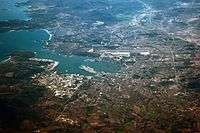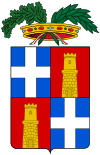Olbia
Olbia (Italian: [ˈɔlbja] (![]()
Olbia | |
|---|---|
| Comune di Olbia | |
 November 2014 aerial photograph of Olbia. The airport and the harbour are both visible. | |
 Coat of arms | |
Location of Olbia 
| |
 Olbia Location of Olbia in Sardinia  Olbia Olbia (Sardinia) | |
| Coordinates: 40°55′N 09°30′E | |
| Country | Italy |
| Region | Sardinia |
| Province | Sassari |
| Frazioni | Berchiddeddu, Murta Maria, Pittulongu, Rudalza-Porto Rotondo, San Pantaleo |
| Government | |
| • Mayor | Settimo Nizzi |
| Area | |
| • Total | 383.64 km2 (148.12 sq mi) |
| Population (30 May 2018)[1] | |
| • Total | 60,345 |
| • Density | 160/km2 (410/sq mi) |
| Demonym(s) | Olbiesi |
| Time zone | UTC+1 (CET) |
| • Summer (DST) | UTC+2 (CEST) |
| Postal code | 07026 |
| Dialing code | 0789 |
| Patron saint | St. Simplicius |
| Saint day | May 15 |
| Website | Official website |
Geography
It is the economic centre of this part of the island (commercial centres, food industry) and is very close to the Costa Smeralda tourist area. It was one of the administrative capitals of the province of Olbia-Tempio, operative since 2005 and canceled after a referendum seven years later. Olbia is a tourist destination thanks to its sea and beaches and also for the large number of places of cultural interest to visit.
History
Although the name is of Greek origin, due to the Greek presence during the 7th century B.C., the city of Olbia was first settled by Phoenicians, according to the archaeological findings. It contains ruins from the Nuragic era to the Roman era, when it was an important port, and the Middle Ages, when it was the capital of the Giudicato of Gallura, one of the four independent states of Sardinia. During the First Punic War, the Romans fought against the Carthaginians and the Sardinians near Olbia, where the general Hanno died in battle.
From 1113 it was the episcopal see of the Diocese of Cività (succeeding to the Diocese of Gallura, the 1070 restoration of the Diocese of Fausania, c. 500–750), which was renamed in 1839 as Diocese of Civita–Tempio until its formal suppression in favor of (in fact merger into) the Diocese of Tempio–Ampurias (also integrating the Diocese of Ampurias, which was in personal union with the see of Civita from 1506)
Main sights
- Romanesque former cathedral of San Simplicio (11th–12th century).
- Church of St. Paul Apostle (medieval)
- National Archaeology Museum
- Pedres Castle
- Several dolmens and a menhir
- Several nuraghes
- Remains of the Roman forum and aqueduct
- Remains of Carthaginian walls
- Fausto Noce park, the largest in Sardinia
- River park of Padrongianus
Sport
Olbia Calcio 1905 represents Olbia in Serie C, the third division of Italian football.
Transport

Olbia is the main connection between Sardinia and the Italian peninsula, with an airport (Olbia – Costa Smeralda), a passenger port (Olbia-Isola Bianca), and a railway from Olbia railway station to Porto Torres, Golfo Aranci and Cagliari. There is an expressway to Nuoro and Cagliari (SS131) and national roads to Sassari (SS199-E840), Tempio Pausania (SS127) and Palau (SS125).
Gallery
- Nuragic holy well temple of Sa testa
.jpg) Olbia, castle of Pedres
Olbia, castle of Pedres Ruins of the Roman aqueduct
Ruins of the Roman aqueduct- Romanesque church of San Simplicio
 The church of S.Paolo of Olbia
The church of S.Paolo of Olbia
Climate
Olbia has a Mediterranean climate (Csa), with mild winters, warm springs and autumns and hot summers.
| Climate data for Olbia, Sardinia | |||||||||||||
|---|---|---|---|---|---|---|---|---|---|---|---|---|---|
| Month | Jan | Feb | Mar | Apr | May | Jun | Jul | Aug | Sep | Oct | Nov | Dec | Year |
| Record high °C (°F) | 25.1 (77.2) |
24.5 (76.1) |
28.0 (82.4) |
27.8 (82.0) |
35.0 (95.0) |
39.9 (103.8) |
42.2 (108.0) |
41.0 (105.8) |
38.3 (100.9) |
32.5 (90.5) |
29.0 (84.2) |
24.0 (75.2) |
42.2 (108.0) |
| Average high °C (°F) | 14.6 (58.3) |
15.2 (59.4) |
16.5 (61.7) |
18.4 (65.1) |
22.7 (72.9) |
27.6 (81.7) |
30.5 (86.9) |
30.8 (87.4) |
27.0 (80.6) |
22.2 (72.0) |
17.8 (64.0) |
15.4 (59.7) |
21.6 (70.8) |
| Average low °C (°F) | 5.2 (41.4) |
5.9 (42.6) |
6.3 (43.3) |
8.2 (46.8) |
11.3 (52.3) |
15.4 (59.7) |
18.3 (64.9) |
18.5 (65.3) |
15.9 (60.6) |
11.8 (53.2) |
8.0 (46.4) |
6.1 (43.0) |
10.9 (51.6) |
| Record low °C (°F) | −3.6 (25.5) |
−3.0 (26.6) |
−2.5 (27.5) |
−1.0 (30.2) |
3.9 (39.0) |
7.0 (44.6) |
12.0 (53.6) |
10.0 (50.0) |
8.9 (48.0) |
4.0 (39.2) |
−1.4 (29.5) |
−4.2 (24.4) |
−4.2 (24.4) |
| Average precipitation mm (inches) | 47.3 (1.86) |
72.6 (2.86) |
63.4 (2.50) |
56.1 (2.21) |
37.4 (1.47) |
18.4 (0.72) |
6.4 (0.25) |
28.1 (1.11) |
40.8 (1.61) |
58.4 (2.30) |
55.6 (2.19) |
97.9 (3.85) |
582.4 (22.93) |
| Average precipitation days | 7 | 8 | 8 | 8 | 4 | 3 | 1 | 3 | 5 | 5 | 6 | 9 | 67 |
| Average relative humidity (%) | 70 | 69 | 65 | 66 | 66 | 58 | 60 | 63 | 67 | 65 | 72 | 72 | 66 |
| Mean monthly sunshine hours | 127 | 138 | 186 | 213 | 279 | 312 | 360 | 316 | 249 | 195 | 138 | 118 | 2,631 |
| Source: Aeronautica Militare [5] | |||||||||||||
References
- Population data from Istat
- Migliorini, Bruno; Tagliavini, Carlo; Fiorelli, Piero. Tommaso Francesco Borri (ed.). "Dizionario italiano multimediale e multilingue d'ortografia e di pronunzia". dizionario.rai.it. Rai Eri. Retrieved 12 February 2016.
- Canepari, Luciano. "Dizionario di pronuncia italiana online". dipionline.it. Retrieved 12 February 2016.
- Olbia e la sua storia: arrivata la cartellonistica con i toponimi storici – Olbia.it
- "Climate Statistics for Olbia, Sardinia". Retrieved 29 March 2013.
Sources and external links
| Wikimedia Commons has media related to Olbia. |

- Official website (in Italian)
- City of Olbia
- GCatholic

